doi:10.12029/gc20160104
“层序(sequence)”一词最早由Sloss(1949)[1]提出并将其定义为“ 由不整合面所限定的地层单位”。在地震地层学的基础上,Vail et al.(1977)[2]重新定义“层序”为“沉积层序”,提出了“由不整合面及其可以对比的整合面所限定的地层单位”的沉积层序概念,标志着作为地层学与沉积学分支学科的“层序地层学”的诞生与建立[3]。两个分水岭式的出版物——AAPG地震地层学26 号专辑[4]及SEPM特别出版物42 卷[5]标志着层序地层学的成熟,并代表了层序地层学进入地层学实践的主流而被誉为Exxon时代[6]。1988 年至今,针对层序形成的复杂过程和响应机制诞生了众多层序模式[7-12],层序地层学进入了“百家争鸣”的后Exxon 时代[6]。Catuneanu(2010)定义层序为“在一个完整的可容纳空间或沉积物供给旋回变化中形成的沉积序列”[13],并强调了地层叠加样式和沉积相关系在层序地层单元和界面识别上的重要性[13-16]。基于沉积旋回的有序叠加进行层序划分与基于碳酸盐沉积作用的特殊响应机制提出的淹没不整合型层序成为近些年层序地层学的重要进展[3],“海平面变化层序”概念的提出和确立标志着层序地层学步入了一个崭新的时代[17, 18]。前人对于华北地台寒武系研究成果较多,孟祥化等[19]最早用现代沉积学的方法研究了代表风暴沉积的竹叶状砾屑灰岩的沉积特征及相序模式,与此同时,冯增昭[20]和王英华[21]分别就岩相古地理和碳酸盐岩岩石学进行了系统研究。近年来,梅冥相从旋回地层角度详细划分了寒武系层序地层[22, 23],特别是对米级旋回的类型及其叠加模式进行了深入分析[22, 24-26],柳永清探讨了张夏组厚层鮞粒灰岩的成因机制[27],史晓颖等利用生物地层及复合层序建立了寒武系层序地层年代格架[28]。在前人研究基础上,笔者通过野外露头详细地质考察并结合室内研究,讨论了寒武系主要的岩相及相序特征,重点利用旋回的叠加样式及沉积趋势识别层序界面,这不仅丰富了华北地台寒武系岩石地层单位的内容[29],也为研究区的层序地层研究提供一些有价值的实际资料。
2 区域地质概况路通沟剖面位于河北省承德县城西南约10 km处(图 1),露头主要分布在兴隆县至承德县主公路边。研究区位于华北地台北缘,在早寒武世中—晚期开始接受沉积[28, 30]。按照新的年代地层划分框架[23, 31],研究区寒武系自下向上包括(图 1):第二统(昌平组、馒头组)、第三统(毛庄组、徐庄组、张夏组、崮山组)和芙蓉统(长山组、凤山组)。寒武纪早期相当于纽芬兰统以及第二统第三阶的地层在本区域缺失,与北京西山地区昌平组平行不整合在新元古界景儿峪组上[23]不同,寒武系底部昌平组砂泥质白云岩直接覆盖在新元古界长龙山组砂质泥页岩地层上,呈平行不整合接触(图 2-A),中间缺失景儿峪组。寒武系顶部厚层竹叶状砾屑灰岩的明显白云石化现象(图 2-B)表明海平面的大幅下降,环境变浅导致的暴露间断成为凤山组第二个层序的界面,类似Exxon 模式中的类型Ⅰ界面[32],同时可作为研究区寒武系—奥陶系的分界面。基于岩相及相序特征变化所代表的旋回性及沉积趋势,可以将河北路通沟寒武系划分为9 个三级层序(图 1)。整个台地沉积序列大致以徐庄组所构成层序的凝缩段为界分为台地发展和台地成熟2 个阶段[33],其中台地发展阶段主要形成特殊的“碎屑岩-碳酸盐岩”沉积,相对海平面上升期间,滨线向古陆推进,潮汐、波浪及风暴易将陆源物质带入沉积区形成碎屑岩单元,而在海平面停滞期及下降期更发育清水环境,形成碳酸盐岩沉积。总之,研究区寒武系环境分异显著,各时期沉积类型互不相同,岩石类型复杂多变,沉积旋回清晰,构成明显的“潮坪相—缓坡相—陆棚相—缓坡相—鮞粒滩相—潮坪相”旋回特征。
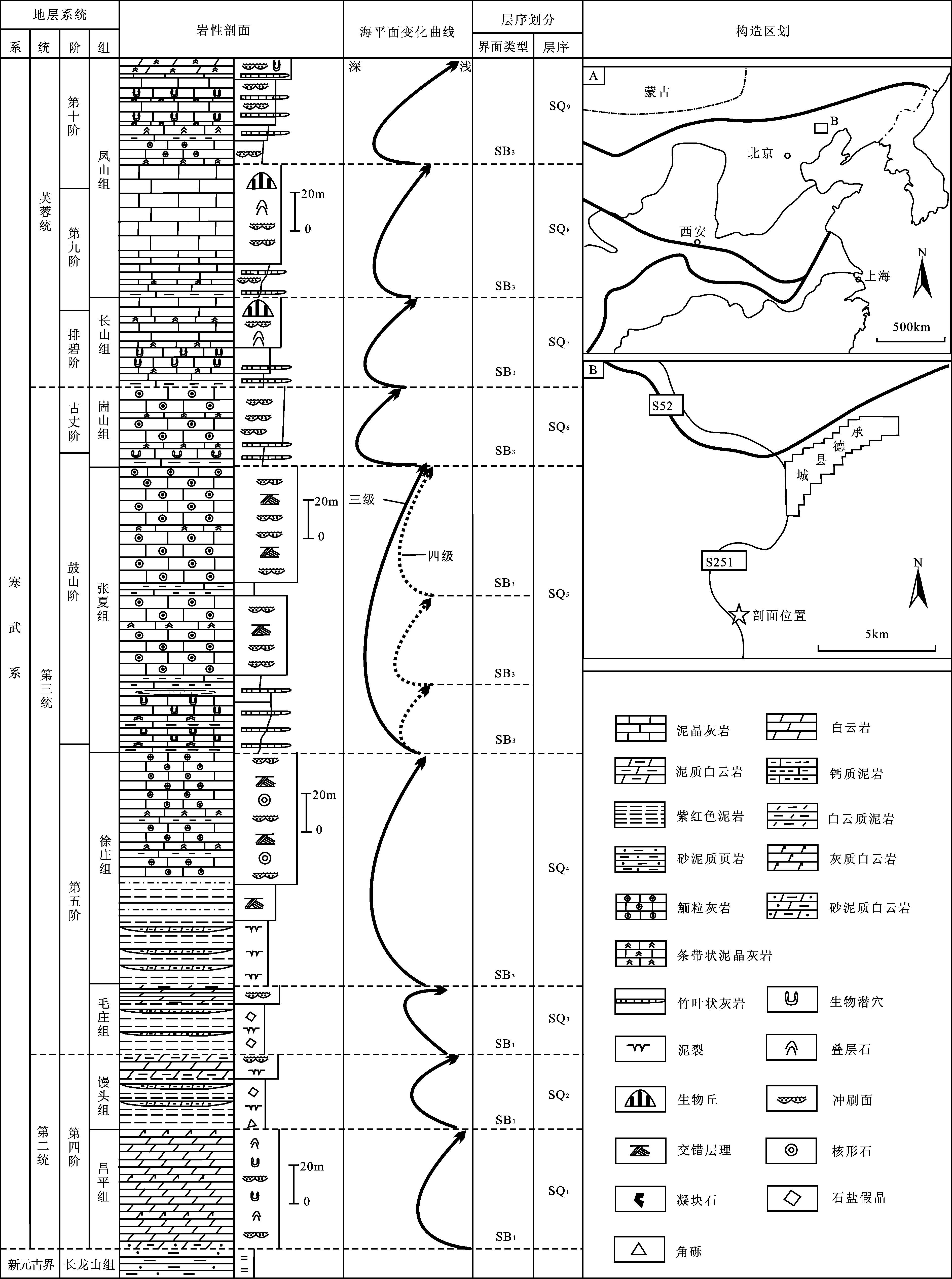
|
图1 河北路通沟剖面寒武系层序地层划分 (SB1和SB3分别代表类型Ⅰ界面及淹没不整合型层序界面,A,B均为区域地质图) Fig.1 Sequence-stratigraphic division of the Cambrian strata along the Lutonggou section in Hebei Province (SB1 and SB3 respectively stand for type 1 sequence boundary and drowning unconformity, A,B are regional geological maps) |
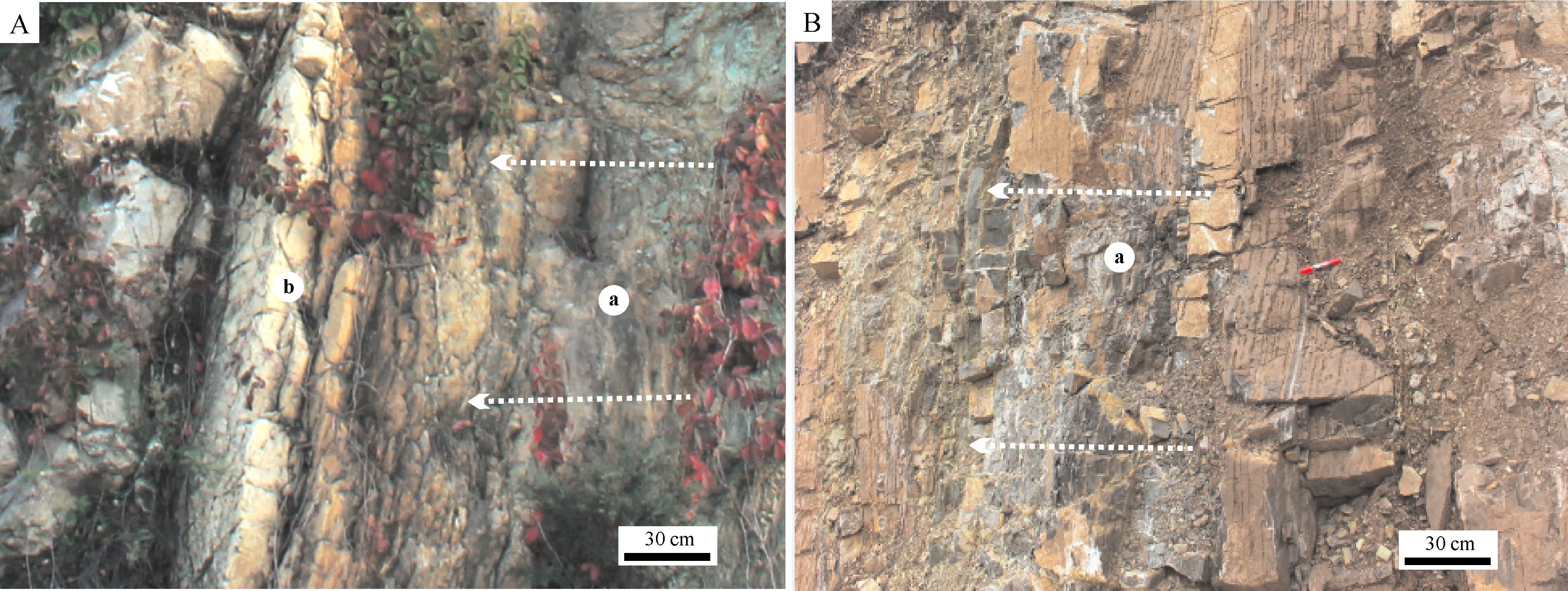
|
图2 河北路通沟剖面寒武系顶底界面特征 A—寒武系底界面(箭头所指),a—新元古界长龙山组潮上坪砂质泥页岩地层,b—寒武系昌平组底部的砂泥质白云岩地层; B—寒武系顶界面(箭头所指),a—凤山组顶部向上白云岩化程度增强的碳酸盐岩地层 Fig.2 Photographs demonstrating top and bottom boundaries of the Cambrian strata along the Lutonggou section in Hebei Province A-Bottom boundary of the Cambrian strata, a-Supratidal flat arenaceous shale strata of Changlongshan Formation in Neoproterozoic, b-Arenopelitic dolomite in the lower part of Changping Formation of the Cambiran; B-Top boundary of the Cambrian strata in the study area (in the arrow direction), a-Strata of dolomitic limestone with the upward intensification of dolomitization at the top of Fengshan Formation |
河北路通沟剖面的寒武系第二统包含昌平组和馒头组,分别构成2 个三级层序SQ1和SQ2(图 1,图 3)。昌平组三级层序SQ1底部为厚40~50 cm 的潮间坪至潮上坪相砂泥质白云岩,代表了海侵初期的沉积,与下伏长龙山组顶部的潮上坪砂质泥页岩地层呈平行不整合接触(图 2-A),沉积间断300 Ma(蓟县运动)。该沉积之上为厚约12 m的潮间坪或潮下坪中厚层灰质白云岩,夹少量薄层泥质白云岩,可见生物潜穴和生物扰动构造,从底部的砂泥质白云岩到此段灰质白云岩代表三级层序SQ1的海侵体系域单元(TST)(图 3),昌平组中部发育厚层块状含凝块石灰质白云岩,厚约20 m,局部可见叠层石构造,主要为高能潮下坪相沉积,组成三级层序SQ1的早期高水位体系域单元(EHST)(图 3)。昌平组上部为一套中厚层-厚层潮下坪至潮间坪白云岩地层,局部发育柱状叠层石构造,厚28 m,构成三级层序SQ1的晚期高水位体系域单元(LHST)(图 3),相比较EHST单元,该段白云石化程度逐渐增强,单层厚度减小,指示沉积环境总体变浅。昌平组与馒头组之间的平行不整合面为该层序界面,馒头组底部的紫红色白云质泥岩直接覆盖在昌平组顶部的块状白云岩地层之上所代表的“跳相”现象是识别该界面的重要标志。
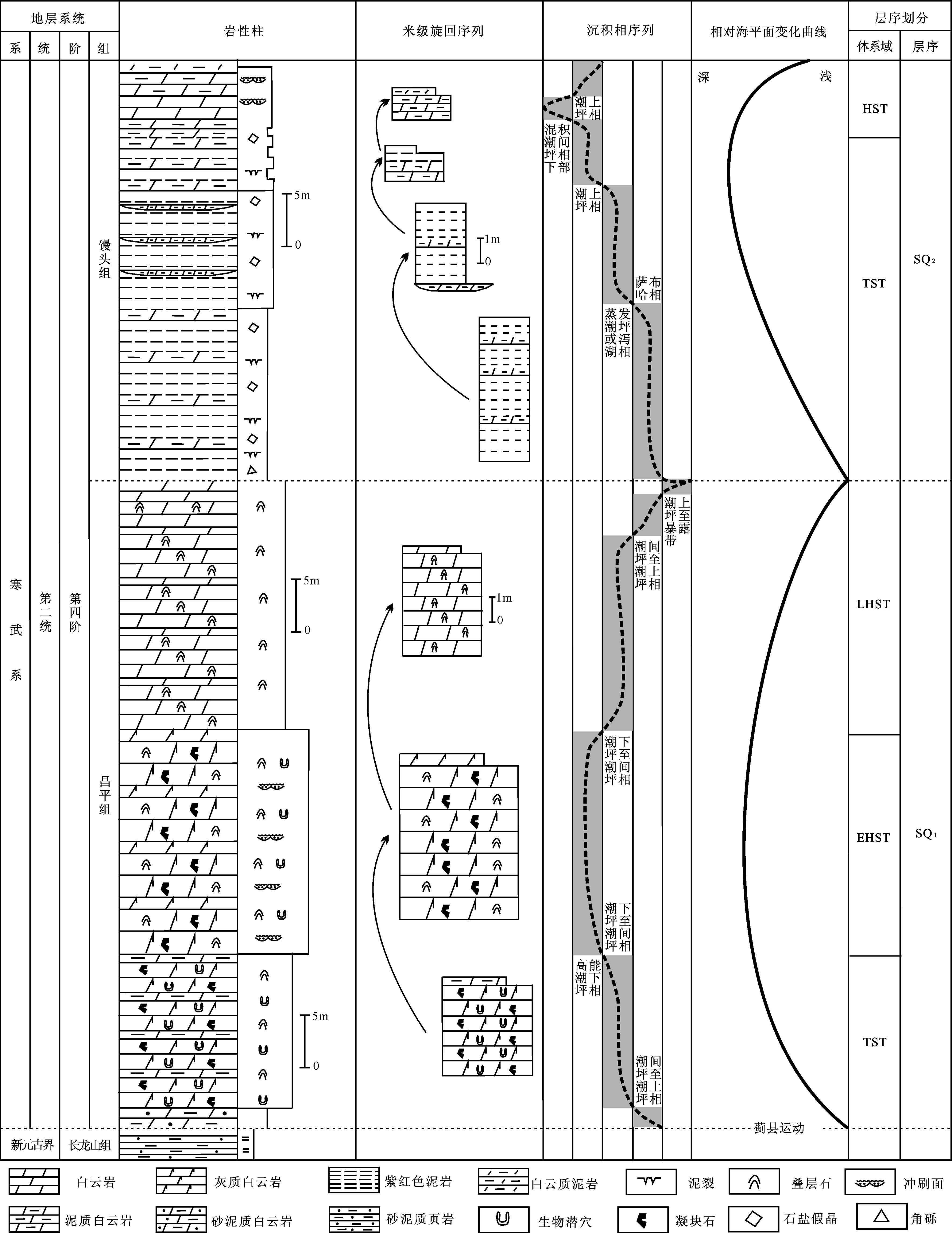
|
图3 路通沟剖面寒武系第二统层序地层划分 Fig.3 Sequence-stratigraphic division for Series 2 of the Cambrian strata along the Lutonggou section |
馒头组构成三级层序SQ2,下部32 m厚的块状紫红色泥岩及白云质泥岩形成了SQ2的TST 单元,见少量石盐假晶,局部夹泥质白云岩透镜体,属萨布哈式蒸发潮坪及潟湖相沉积。该套沉积向上逐渐变为中薄层泥质白云岩与厚层白云质泥岩互层关系,白云岩的增加表明了向蒸发潮上坪环境的转变。三级层序SQ2的高位体系域单元(HST)上部是厚8 m的潮上坪相及混积潮间坪相泥晶白云岩及泥质白云岩地层,局部可见冲刷面。
4 寒武系第三统层序划分研究区寒武系第三统主要包括毛庄组、徐庄组、张夏组和崮山组,地层发育连续,它们分别构成了4 个三级层序SQ3-SQ6(图 1,图 4)。以徐庄组中部陆棚相灰绿色薄层砂质泥页岩所代表的凝缩段为界,毛庄组及徐庄组下部的潮坪相紫红色泥岩转变为大套的厚层碳酸盐岩沉积,也标志着从徐庄组顶部开始进入碳酸盐岩台地成熟阶段[33]。第三统地层特别是张夏组中可见较多以类型Ⅲ层序界面[34]为主的淹没不整合型层序[35],其受控于复合海平面变化,并以“CS(凝缩段)+HST”沉积序列[35]为典型特征(图 4)。
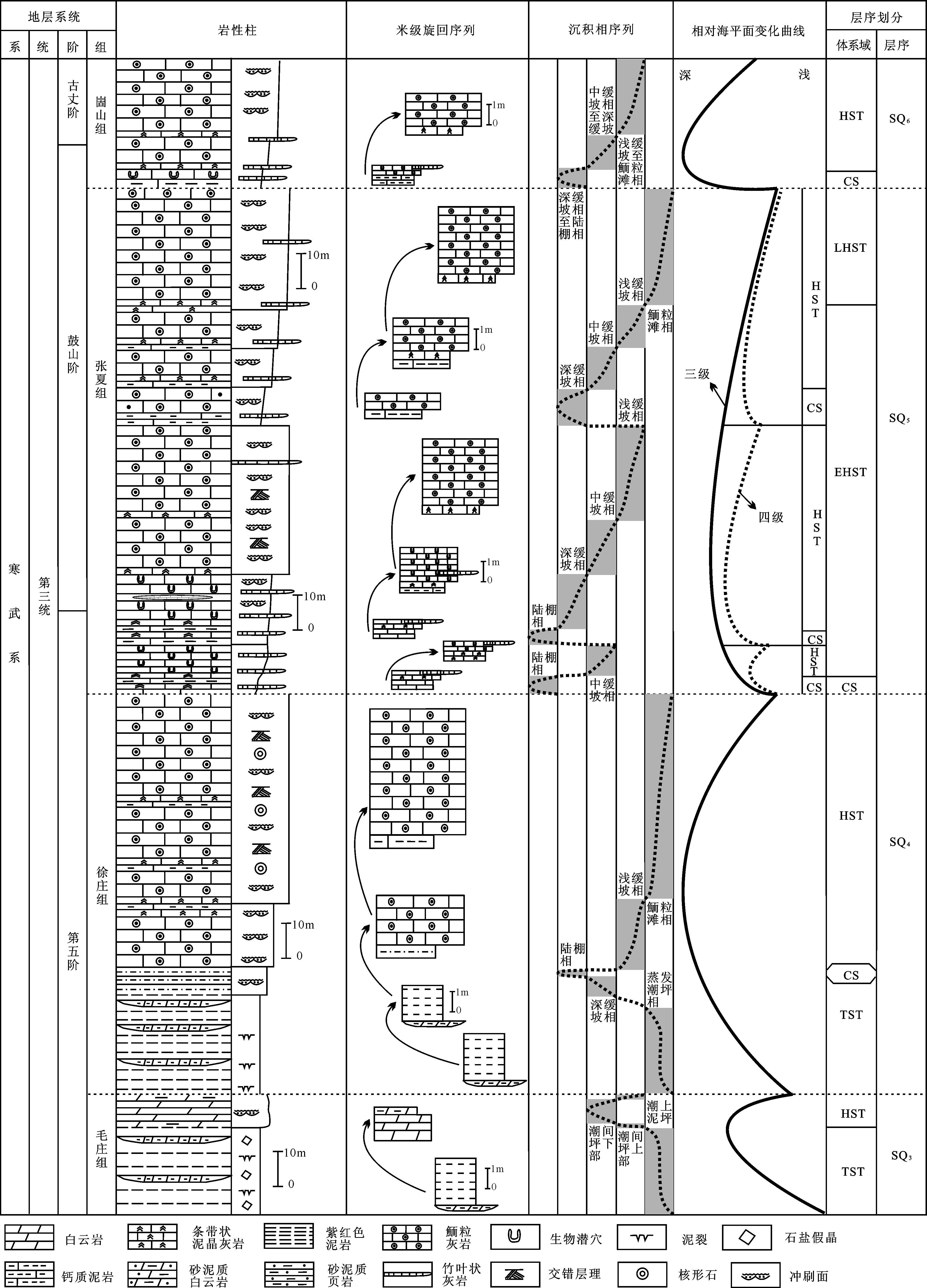
|
图4 路通沟剖面寒武系第三统层序地层划分 Fig.4 Sequence-stratigraphic division for Series 3 of the Cambrian along the Lutonggou section |
毛庄组组成三级层序SQ3,其沉积相序列与馒头组较为相似,包括两部分地层。下部为厚层块状紫红色及砖红色铁质白云质泥岩,属于潮上泥坪的红层沉积(图 5-A),厚度25 m左右,与馒头组不同的是红层沉积中夹灰黄色泥质白云岩透镜体,表明了沉积环境的加深特征,构成三级层序SQ3的TST沉积。上部为一套潮间坪相泥晶白云岩地层,厚10m左右,中上部厚层泥晶白云岩与中薄层泥质白云岩组成环潮坪型米级旋回(图 5-B),这套白云岩地层组成三级层序SQ3的HST单元。由此可见,SQ3层序的顶、底界面具有相似性,均为下伏地层向上变浅、上覆地层向上加深的沉积相转换面。
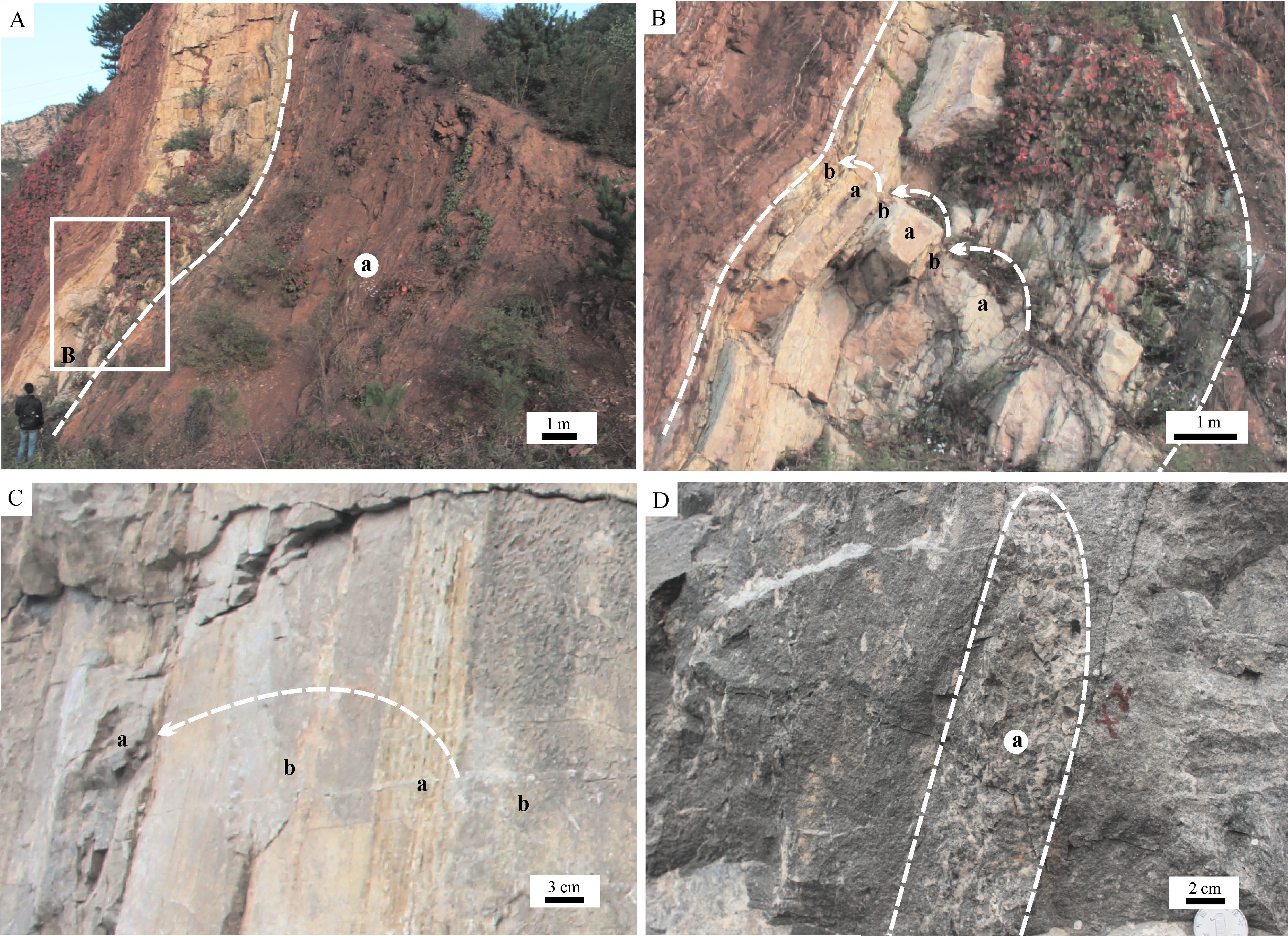
|
图5 毛庄组与徐庄组岩石学及层序特征 A—毛庄组岩性特征,a—毛庄组下部紫红色白云质泥岩,白色虚线为毛庄组下部泥岩与上部白云岩的界面;B—A图中B的放大图,厚层泥晶白云岩(a)与中薄层泥质白云岩(b)构成环潮坪型碳酸盐岩米级旋回(箭头所指);C—徐庄组上部中薄层泥质条带灰岩夹钙质泥岩(a)与厚层鮞粒灰岩(b)构成潮下型米级旋回(箭头所指);D—徐庄组鮞粒灰岩中小型核形石造礁体(a),其周围也发育核形石 Fig.5 Photograph demonstrating petrological and sequence characteristics of Maozhuang and Xuzhuang Formation A-The feature of Maozhuang Formation, a-Amaranth dolomitic mudstone in the lower Maozhuang Formation, the white dotted line refers to the boundary between mudstone and dolomite;B-The amplification of B in A, peritidal meter-scale cycle (in the arrow direction) made up of both thick-bedded dolomicritic (a) and thin-bedded argillaceous dolomite (b);C-The subtidal meter-scale cycle (in the arrow directon) made up of both thin bedded pelitic stripe limestone with calcareous mudstone (a) and thick bedded oolitic limestone (b) in the upper part of Xuzhuang Formation; D-Small and medium size oncolite reef-building deposits (a) and oncolite around above deposits |
徐庄组对应的三级层序SQ4,尽管露头覆盖较为严重,尤其是中下部的地层,但是垂直露头仍是表现出徐庄组从潮坪相地层变化到鲕粒滩相的序列。组成该层序TST 的为紫红色厚层块状白云质泥岩,为潮坪或蒸发潮坪相沉积,其中夹较多的灰黄色泥质白云岩透镜体。因此,相比SQ3中TST 沉积环境更深一些。中部灰绿色薄层砂质泥页岩为SQ4的凝缩段单元,属陆棚相沉积,指示了一次较大规模的海侵过程。上部中薄层泥质条带泥晶灰岩夹钙质泥页岩与厚层块状鲕粒灰岩互层组成潮下型米级旋回(图 5-C),为一个从浅缓坡到高能鲕粒滩的变化序列,表现为鲕粒灰岩层向上变厚,从厚层到块状,组成了SQ4的HST单元(图 4),与TST形成了鲜明的对比。此外,在块状鲕粒灰岩层中可见小型核形石造礁体(图 5-D),也见漂浮在细粒中的核形石(图 5-D),从宏观及产出特征上看沉积细粒与核形石可构成连续谱系的特点。张夏组构成的三级层序SQ5以发育厚层颗粒滩相鮞粒灰岩为主要特征,还伴有风暴砾屑灰岩透镜体、中缓坡相条带状泥晶灰岩及深水陆棚相钙质泥页岩透镜层沉积,体现了岩性的多样性以及非滩相地层与鮞粒滩之间呈有规律的变化关系。三级层序SQ5主要由陆棚相薄层条带灰岩夹钙质泥页岩到块状厚层鮞粒灰岩组成一个向上变浅的沉积相序列所构成(图 4),其顶、底界面(图 6-A、B)均属于典型的淹没不整合型层序界面[35],主要特征为具有浓缩段性质的薄层钙质泥页岩直接被高水位体系域厚层块状鮞粒灰岩覆盖,代表了台地淹没后碳酸盐岩工厂关闭而发育薄层深水泥页岩沉积[36]的现象。造成台地淹没的原因多为台地快速沉降导致的快速海平面变化,也可能包括海洋学或者气候的变化的影响[37]。基于层序内岩相及沉积相序列表现出的不同级次旋回变化特征,可识别并划分出张夏组“复合三级层序”SQ5 内部包括3 个四级亚层序,各四级层序均以“CS+HST”沉积序列(图 4)为特征,下部陆棚相薄层-中薄层条带泥晶灰岩夹钙质泥页岩地层(图 6-C)构成凝缩段(CS)单元,上部中厚层生物潜穴灰岩或厚层鮞粒灰岩则组成HST单元(图 4)。层序内部还发育由薄层条带泥晶灰岩与厚层鮞粒灰岩组成的潮下型米级旋回(图 6-D),其中,第一个(图 6-E)和第二个四级亚层序的顶界面与三级层序SQ5 的顶、底界面性质相似,均属于淹没不整合型层序界面,这些界面均表现为下伏地层向上快速加深的沉积序列,只是厚度和级别有差异。所以,上述三级层序和四级亚层序都属于较为典型的淹没不整合型层序[35],显然这些界面都是在相对整合的地层中划分的,是区别于Exxon 模式中类型Ⅰ和类型Ⅱ界面[28, 35]的类型Ⅲ界面。
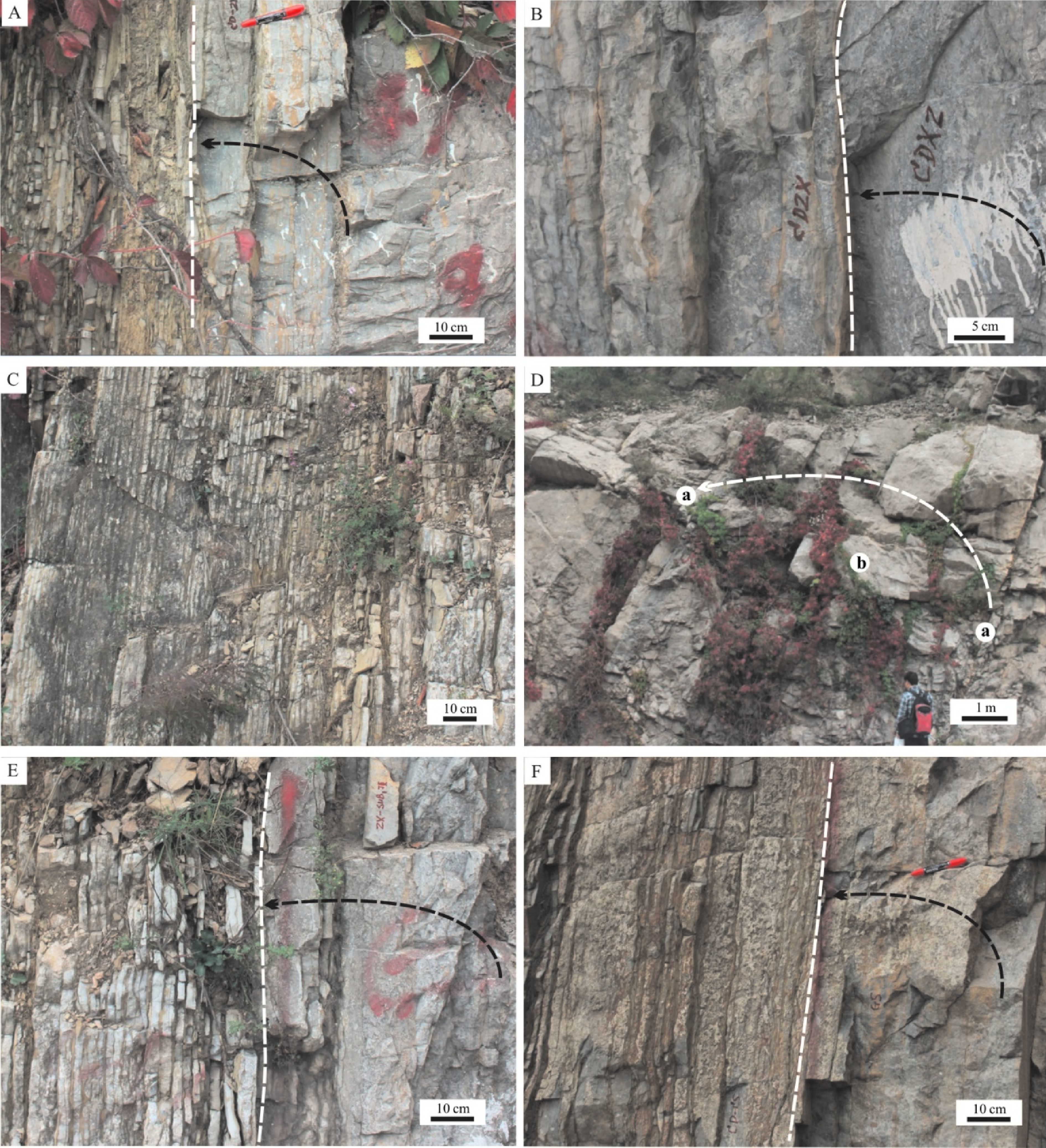
|
图6 研究区寒武系张夏组及崮山组层序及其界面 A—张夏组层序SQ5的顶界面(箭头所指);B—张夏组层序SQ5的底界面(箭头所指);C—张夏组第二个四级亚层序内部陆棚相薄层条带泥晶灰岩;D—张夏组顶部由薄层条带泥晶灰岩(a)与厚层块状鮞粒灰岩(b)组成的潮下型米级旋回(箭头所指),E—张夏组第一个四级亚层序的顶界面(箭头所指);F—崮山组层序SQ6的顶界面(箭头所指) Fig.6 Photographs showing the boundary of the sequence in Cambrian Zhangxia Formation and Gushan Formation in the study area A-Top boundary of Zhangxia Formation sequence SQ5 (in the arrow direction);B-Bottom boundary of Zhangxia Formation sequence SQ5 (in the arrow direction);C-Thin-bedded stripe micrite of shelf facies in the second subsequence of Zhangxia Formation;D-Subtidal meter-cycle (in the arrow direction) made up of both thin-bedded stripe micrite (a) and thick bulk oolitic limestone (b);E-Top boundary in the first subsequence of Zhangxia Formation (in the arrow direction);F-Top boundary of Gushan Formation sequence SQ6 (in the arrow direction) |
崮山组三级层序SQ6内部特征与张夏组形成的三级层序SQ5类似,下部地层以中薄层钙质泥页岩与中薄层生物潜穴泥晶灰岩互层组成L-M型米级旋回为特征,向上逐渐变为沉积环境较浅的中薄层泥质条带泥晶灰岩与厚层块状鲕粒灰岩组成的潮下型米级旋回,构成浅缓坡至高能鲕粒滩相沉积。层序SQ6底界面以崮山组底部的中薄层钙质泥页岩直接覆盖在张夏组顶部厚层鮞粒灰岩相为主要特征(图 6-A),而顶界面则以崮山组顶部缓坡相块状鮞粒灰岩被长山组底部陆棚相薄层钙质泥岩与中薄层灰泥岩覆盖(图 6-F)。由此可见,层序SQ6构成一个总体向上变浅的非对称旋回序列[35],顶底界面均为典型的淹没不整合面,属淹没不整合型层序类型。
整体上,河北路通沟剖面的寒武系第三统地层由红层沉积为主的潮坪相泥岩变化为以缓坡相颗粒灰岩为主的浅水沉积,这不仅代表了沉积环境的变化,也标志着台地由形成阶段向成熟阶段的演化。在台地形成的成熟阶段,徐庄组、张夏组及崮山组各组的顶部均发育中到厚层的块状鮞粒滩相灰岩,大多形成于HST及LHST单元(图 4),其形成机制并不能简单的理解为“台地边缘滩”的产物,而更有可能与海平面下降时形成的强迫性海退过程有关[38]。此外,与北京西郊下苇甸剖面同时期发育较多生物丘不同[23, 39],研究区寒武系第三统地层中基本未见生物丘及柱状叠层石沉积,可能与本地区的古环境变迁及古生物演变特征有关。
5 寒武系芙蓉统层序划分相比寒武系第三统以发育厚层块状颗粒滩相鮞粒灰岩为主,河北路通沟剖面寒武系芙蓉统地层则发育大量竹叶状砾屑灰岩及较多叠层石生物丘灰岩[40]。芙蓉统地层包括长山组和凤山组。长山组构成三级层序SQ7(图 7,图 8-A),其顶、底界面均为厚层泥晶灰岩与上覆的陆棚相灰绿色钙质泥岩或中薄层泥灰岩之间的岩相突变面,这种岩相突变所代表的快速海侵作用是判别淹没不整合面界面的重要标志。下部陆棚相钙质泥岩与泥质条带灰岩组成了SQ7的CS 单元(图 7),其中可见小型生物丘灰岩(图 8-B),向上逐渐变为泥质条带泥晶灰岩与厚层生物潜穴灰岩或泥晶生物丘组成的潮下型米级旋回(图 8-C),构成层序的HST单元。竹叶状砾屑灰岩发育在条带状泥晶灰岩之中,并且还保留了条带泥晶灰岩的样式,属于原地型风暴沉积[23(] 图8-D),潮下型米级旋回的下部泥质条带泥晶灰岩是竹叶状砾屑灰岩构成的风暴沉积的主要物源。层序顶部发育大型泥晶生物丘(图 8-E),其中可见少量柱状叠层石构成(图 8-F)。

|
图7 路通沟剖面寒武系芙蓉统层序地层划分 Fig.7 Sequence-stratigraphic division of the Cambrian Furongian Series on the Lutonggou section |
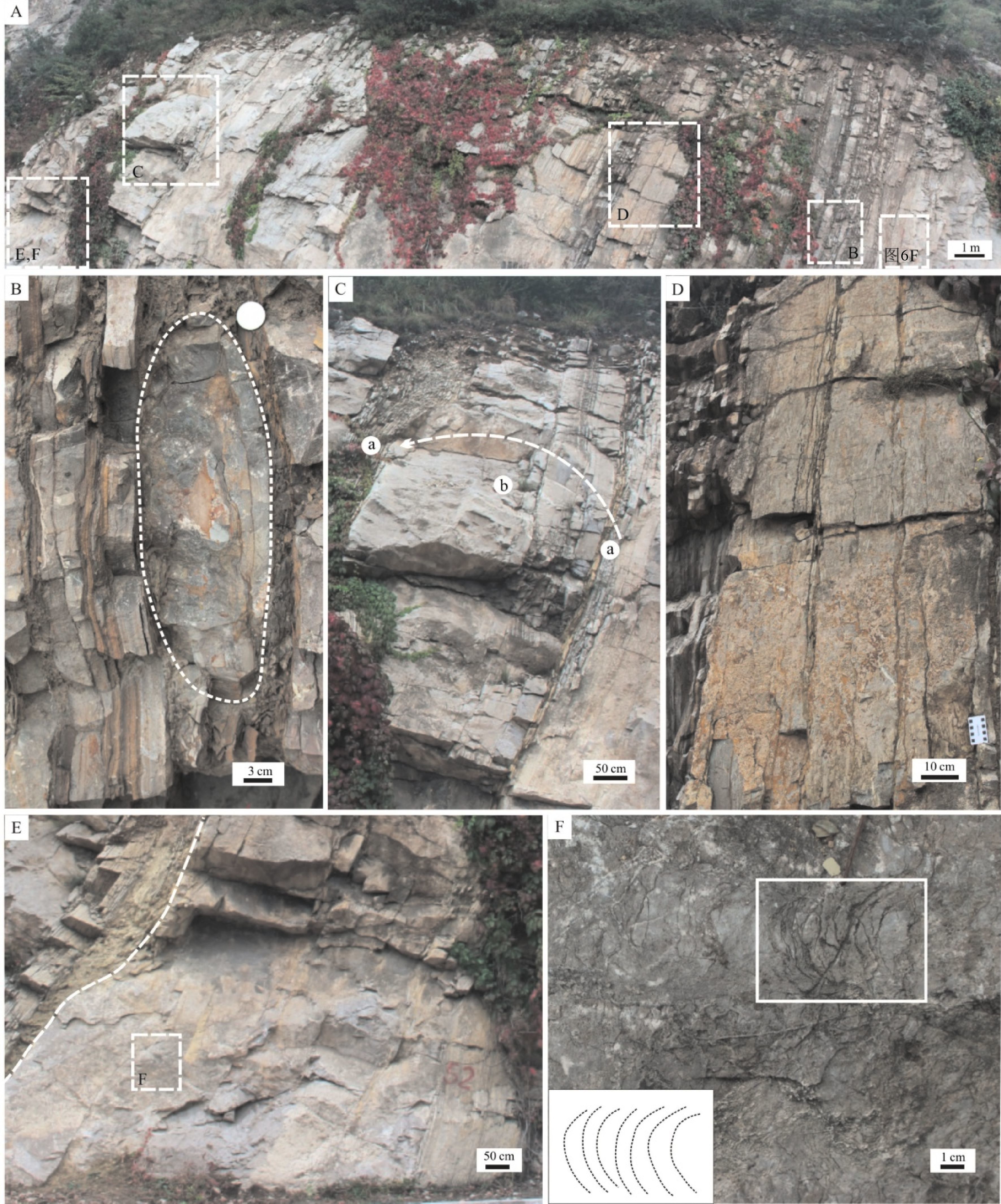
|
图8 研究区寒武系长山组层序、层序界面及沉积组构特征 A—长山组层序全景图; B—长山组底部小型深水生物丘; C—长山组上部泥质条带泥晶灰岩(a)与厚层泥晶生物丘(b)构成的潮下型米级旋回(箭头所指); D—长山组中部竹叶状砾屑灰岩; E—长山组顶部泥晶生物丘,白色虚线为长山组与凤山组界面; F—E图中生物丘中的柱状叠层石构造 Fig.8 Photographs demonstrating the sedimentary structure and sequence boundaries and sequence in Cambrian Changshan Formation in the study area A-The panoramagram of the Changshan Formation sequence; B-Small size bioherm in the lower part of Changshan Formation; C-The subtidal meter-cycle (in the arrow direction) made up of both argillaceous stripe micrite (a) and thick bedded micritic bioherm (b) in the upper part of Changshan Formation; D-Limestone conglomerate in the middle part of Changshan Formation; E-Micrite bioherm at the top of Changshan Formation, white dotted line refers to the boundary between Changshan and Fengshan Formation; F-Columnar stromatolitic structure of the bioherm in Fig. E |
凤山组构成2 个三级层序SQ8和SQ9(图 7),尤其以SQ8层序顶部块状叠层石生物丘灰岩中的水道沉积及生物丘顶部的鲕粒滩灰岩披覆层最为引人注目。SQ8层序底部陆棚相中薄层钙质泥岩直接覆盖在厚层泥晶生物丘之上(图 8D),为典型的淹没不整合型层序。中部变为中薄层泥质条带泥晶灰岩与块状泥晶生物丘灰岩互层组成的潮下型米级旋回,构成EHST单元。随着海平面下降,沉积环境变浅,泥质条带灰岩逐渐变薄甚至消失,浅缓坡相厚层块状泥晶生物丘灰岩组层序的LHST单元(图 7),与SQ7层序内部的生物丘构造(图 8-B、D)明显不同,该泥晶生物丘中发育多种叠层石构造,包括波状(图 9-A)、柱状(图 9-B)及丘状叠层石,为碳酸盐泥丘[41]或微生物礁[42]沉积,此外该生物丘中还发育水道沉积,并被鲕粒灰岩充填(图 9-C)。层序顶部薄层泥质条带泥晶灰岩与厚层鲕粒灰岩互层组成潮下型米级旋回(图 9-D),构成LHST 中生物丘的披覆层,这与北京西郊下苇甸剖面凤山组第一个层序顶界面被钙质泥岩覆盖[43]明显不同,鮞粒灰岩披覆层的发育无疑与晚期高水位体系中的强迫性海退过程[38, 44]有关。三级层序SQ9的底部地层也为具有凝缩性质的陆棚相泥质条带泥晶灰岩夹钙质泥岩,组成CS 单元。向上变为中薄层泥质条带泥晶灰岩夹竹叶状砾屑灰岩与厚层块状生物潜穴及生物扰动含生物屑泥晶灰岩互层组成潮下型米级旋回,构成HST单元。层序顶部发育薄层竹叶状砾屑灰岩与中厚层条带状泥晶白云岩互层,构成环潮坪型米级旋回(图 2-A),为潮间至潮上坪沉积,白云岩地层的顶界面为典型的暴露间断面。显然,SQ9层序的顶界面属于Exxon 模式中定义的类型Ⅰ界面。

|
图9 研究区寒武系凤山组层序SQ8的沉积特征 A—凤山组顶部生物丘中的波状叠层石构造;B—凤山组SQ8层序顶部生物丘中的柱状叠层石构造;C—凤山组SQ8层序顶部生物丘中的大型冲蚀构造(a),其被鮞粒灰岩充填;D—凤山组SQ8层序顶部的鮞粒灰岩披覆层,其由泥质条带泥晶灰岩(a)与厚层鮞粒灰岩(b)组成的潮下型米级旋回(箭头所指)构成 Fig.9 Photos showing sedimentary feature of SQ8 of the Cambrian Fengshan Formation in the study area A-The wave-shaped stromatolite of the bioherm at the top of Fengshan Formation, B-The columnar stromatolite of the bioherm at the top of sequence SQ8 of Fengshan Formation, C-The wash-out structure filled with oolitic limestone within bioherm at the top of sequence SQ8 of Fengshan Formation, D-The oolitic limestone overlying strata at the top of sequence SQ8 of Fengshan Formation, including the subtidal metercycle(in the arrow direction) made up of both argillaceous stripe micrite (a) and thick oolitic limestone (b) |
河北路通沟剖面寒武系是一个发育在二级海侵背景下的陆表海型沉积序列,以第三统徐庄组灰绿色泥岩为界,岩相从潮坪相红层沉积转变为缓坡相厚层碳酸盐岩沉积,不仅代表了沉积环境有序的时间变化,还标志着台地从形成阶段到成熟阶段的演化。根据沉积序列及内部的旋回特征和相序组构将寒武系划分为9 个三级层序,岩相及相序特征复杂多变,层序界面类型不一。第三统及芙蓉统以缓坡型台地沉积为主,层序界面多为淹没不整合型界面,造成淹没台地的控制因素推测为台地快速沉降所形成的快速海平面升高。第三统在强迫性海退期间发育更多的块状鮞粒灰岩,与芙蓉统强迫性海退期间发育柱状叠层石生物丘明显不同,柱状叠层石生物丘及其上部的鮞粒披覆层是研究区重要的沉积学现象,其形成机理及其蕴含的科学问题还有待于进一步调查研究。
致谢:感谢审稿专家和编辑部李亚萍老师提出的修改建议和意见!
| [1] | Sloss L L, Krumbein W C, Dapples E C. Integrated Facies Analysis[M]. Geological Society of America Memoirs, 1949: 91- 124.( 1) 1) |
| [2] | Vail P, Mitchum R, Iii S. Seismic Stratigraphy and Global Changes of Sea Level: Part 3. Relative Changes of Sea Level from Coastal Onlap: Section 2. Application of Seismic Reflection Configuration to Stratigraphic Interpretation[M]. M 26: Seismic Stratigraphy- Applications to Hydrocarbon Exploration, 1977: 63-81.( 1) 1) |
| [3] | 梅冥相. 层序地层学发展历程中的三个误判[J]. 地学前缘. 2014, 21(2): 67-80. Mei Mingxiang. Three misreadings during the developing course of sequence stratigraphy[J]. Earth Science Frontiers,2014,21(2):67- 80 (in Chinese with English abstract).( 2) 2) |
| [4] | Payton C E. Seismic Stratigraphy-Applications to Hydrocarbon Exploration[M]. Memoir 26, American Association of Petroleum Geologists, 1977.( 1) 1) |
| [5] | K W C, S H B, Kendall C G. Sea Level Changes:An Integrated Approach[M]. SEPM Special Publication 42, 1988: 1-499.( 1) 1) |
| [6] | 梅冥相. 从正常海退与强迫型海退的辨别进行层序界面对比:层序地层学进展之一[J]. 古地理学报, 2010, 12(5): 549-564. Mei Mingxiang. Correlation of sequence boundaries according to discerning between normal and forced regressions: The first advance in sequence stratigraphy[J].Journal of Palaeogeography, 2010,12(5):549-564 (in Chinese with English abstract).( 2) 2) |
| [7] | Mitchum Jr. R M, Van Wagoner J C. High- frequency sequences and their stacking patterns: sequence-stratigraphic evidence of high-frequency eustatic cycles[J]. Sedimentary Geology, 1991, 70 (2/4): 131-160.( 1) 1) |
| [8] | Posamentier H W, Vail P R. Eustatic Controls on Clastic Deposition Ⅱ. Sequence and Systems Tract Models[M]. Special Publications, 1988: 125-154. |
| [9] | Wagoner J C V, Mitchum R M, Campion K M, et al. Siliciclastic sequence stratigraphy in well logs, cores, and outcrops: concepts for high- resolution correlation of time and facies[M]. Aapg Special Volumes, 1990: 55. |
| [10] | Hunt D, Tucker M E. Stranded parasequences and the forced regressive wedge systems tract: deposition during baselevelfall[ J]. Sedimentary Geology, 1992, 81(1/2): 1-9. |
| [11] | Galloway W E. Genetic stratigraphic sequences in basin analysis Ⅱ: Application to Northwest Gulf of Mexico Cenozoic Basin[J]. AAPG Bulletin. 1989, 73(2): 143-154. |
| [12] | Embry A F, Johannessen E P. T-R Sequence Stratigraphy, Facies Analysis and Reservoir Distribution in the Uppermost Triassic- Lower Jurassic Succession, Western Sverdrup Basin, Arctic Canada[M]. Norwegian Petroleum Society Special Publications, 1993: 121-146.( 1) 1) |
| [13] | Catuneanu O, Bhattacharya J P, Blim M D, et al. Sequence stratigraphy: common ground after three decades of development[J]. stratigraphy. 2010, 28: 21-34.( 1) 1) |
| [14] | Catuneanu O, Christopher W E G, Andrew D. Miall H W P A, et al. Sequence Stratigraphy: Methodology and Nomenclature[J]. Newsletters on Stratigraphy. 2011, 44(3): 173-245. |
| [15] | Catuneanu O, Zecchin M. High-resolution sequence stratigraphy of clastic shelves Ⅱ: Controls on sequence development[J]. Marine and Petroleum Geology. 2013, 39(1): 26-38. |
| [16] | 梅冥相,马永生. 从旋回层序的特征论地层记录的两种相变面及两种穿时性[J].地层学杂志, 2001, 25(2): 150-153. Mei Mingxiang, Ma Yongsheng. On two kinds facies change surface and two kinds of diachrononism stratigraphical records according to the natures of cyclic- sequences[J].Journal of Stratigraphy, 2001, 25(2): 150- 153 (in Chinese with English abstract).( 1) 1) |
| [17] | 梅冥相. 从沉积层序到海平面变化层序-层序地层学一个重要的新进展[J]. 地层学杂志, 2015, 39(1): 58-73. Mei Mingxiang.Conceptual change from depositional sequences to eustatic sequences:an important development in sequence stratigraphy[J].Journal of Stratigraphy, 2015, 39(1): 58- 73 (in Chinese with English abstract).( 1) 1) |
| [18] | Boulila S, Galbrun B, Miller K G, et al. On the origin of Cenozoic and Mesozoic"third-order"eustatic sequences[J]. Earth-Science Reviews, 2011, 109(3): 94-112.( 1) 1) |
| [19] | 孟祥化,乔秀夫,葛铭. 华北古浅海碳酸盐风暴沉积和丁家滩相序模式[J]. 沉积学报, 1986, 4(2): 1-18. Meng Xianghua, Qiao Xiufu, Ge Ming. Storm deposits of the paleo- epicontinental sea and the Dingjiatan model in the Cambrian of the North China Platform[J]. Acta Sedimentologia Sinica, 1986, 4(2): 1-18 (in Chinese with English abstract).( 1) 1) |
| [20] | 冯增昭,王英华,张吉森,等. 华北地台早古生代岩相古地理[M]. 北京: 地质出版社, 1990: 3-49. Feng Zengzhao, Wang Yinghua, Zhang Jisen, et al. Lithofacies Palaogeography of the Early Palaeozoic of North China Platform[M]. Beijing: Geological Publishing House, 1990: 3- 49 (in Chinese with English abstract).( 1) 1) |
| [21] | 王英华,张秀莲,杨承运. 华北地台早古生代碳酸盐岩岩石学[M]. 北京: 地震出版社, 1989: 1-133. Wang Yinghua, Zhang Xiulian, Yang Chengyun. Carbonate Rocks for the Early Paleozoic of the North China Platform[M].Beijing: Seismological Press,1989:1- 133(in Chinese with English abstract).( 1) 1) |
| [22] | 梅冥相. 从旋回的有序叠加形式到层序的识别和划分:层序地层学进展之三[J]. 古地理学报, 2011, 13(1): 37-54. Mei Mingxiang. From vertical stacking pattern of cycles to discerning an division of sequences: the third advance in sequence stratigraphy[J]. Journal of Palaeogeography, 2011,13(1):37- 54 (in Chinese with English abstract).( 1) 1) |
| [23] | 梅冥相. 华北寒武系二级海侵背景下的沉积趋势及层序地层序列:以北京西郊下苇甸剖面为例[J]. 中国地质, 2011, 38(2): 317- 337. Mei Mingxiang. Depositional trends and sequence- stratigraphic successions under the Cambrian second- order transgressive setting in the North China Platform: A case study of the Xiaweidian section in the western suburb of Beijing[J]. Geology in China,2011, 38(2): 317-337 (in Chinese with English abstract).( 4) 4) |
| [24] | 梅冥相,梅仕龙. 华北中寒武世张夏组复合海平面变化旋回层序[J]. 沉积学报. 1997, 15(4): 7-12. Mei Mingxiang, Mei Shilong. Cyclic- sequence of Composite sea - level change developed in Zhangxia Formation of Middle- Cambrian in North- China[J].Acta Sedimentologica Sinica,1997, 15(4):7-12 (in Chinese with English abstract).( 1) 1) |
| [25] | 梅冥相. 碳酸盐台地的地层层序格架及旋回地层级次[J].沉积与特提斯地质, 1992(2): 44-50. Mei Mingxiang. Sequence stratigraphic framework and cyclic stratigraphic order of carbonate platform [J].Sedimentary Geology and Tethyan Geology, 1992(2): 44- 50 (in Chinese with English abstract). |
| [26] | 梅冥相. 碳酸盐岩米级旋回层序的成因类型及形成机制[J]. 沉积与特提斯地质. 1993, 13(6): 34-43. Mei Mingxiang. Genetic types and mechanisms of the carbonate rock meter- scale cyclic sequences[J].Sedimentary Geology and Tethyan Geology,1993, 13(6): 34- 43 (in Chinese with English abstract).( 1) 1) |
| [27] | 柳永清,孟祥化,葛铭. 华北地台中寒武世鲕滩碳酸盐旋回沉积、古海平面变动控制及旋回年代学研究[J]. 地质科学, 1999, 34(4): 442-450. Liu Yongqing, Meng Xianghua,Ge Ming.The sea- level change forcing cycles of oolitic carbonate and cyclochrological applications[J].Scientia Geologica Sinica. 1999, 34(4): 442- 450 (in Chinese with English abstract).( 1) 1) |
| [28] | 史晓颖, 陈建强, 梅仕龙. 华北地台东部寒武系层序地层年代格架[J]. 地学前缘, 1997, 4(3/4): 165-177. Shi Xiaoying, Chen Jianqiang, Mei Shilong. Sequencestratigraphic framework of the Cambrian in the eastern part of the North-China Platform[J]. Earth- science Frontiers, 1997, 4(3/4): 161-173 (in Chinese with English abstract).( 1) 1) |
| [29] | 梅冥相. 从地层记录的特性论岩石地层学的困惑[J]. 地层学杂志, 1996, 20(03): 207-212. Mei Mingxiang. Discussion on the perlexity in lithostratigraphy in terms of the particularity of stratigraphical records[J]. Journal of Stratigraphy, 1996, 20(03): 207- 212 (in Chinese with English abstract).( 1) 1) |
| [30] | Meng Xianghua, Ge, Ming Tucker, Maurice E. Sequence Sequence stratigraphy, sea- level changes and depositional systems in the Cambro-Ordovician of the North China carbonate platform[J]. Sedimentary Geology, 1997, 114(1/4): 189-222.( 1) 1) |
| [31] | 彭善池. 全球寒武系四统划分框架正式确立[J]. 地层学杂志, 2006, 30(2): 147-148 Peng Shanchi. A new global framework with four series for Cambrian system[J].Journal of Stratigraphy, 2006, 30(2): 147- 148 (in Chinese with English abstract).( 1) 1) |
| [32] | 罗顺社, 张建坤, 陈小军,等. 辽西凌源地区雾迷山组沉积特征与层序地层[J]. 中国地质, 2010, 37(2):394-403. Luo Shunshe, Zhang Jiankun, Chen Xiaojun, et al. Sedimentary characteristics and sequence stratigraphy of Wumishan Formation in Lingyuan area, western Liaoning Province[J].Geology in China, 2010,37(2):394-403(in Chinese with English abstract).( 1) 1) |
| [33] | 梅冥相, 马永生, 梅仕龙, 等. 华北寒武系层序地层格架及碳酸盐台地演化[J]. 现代地质, 1997, 11(3): 16-23. Mei Mingxiang, Ma Yongsheng, Mei Shilong et al. Sequencestratigraphic and carbonate- platform evolution for the Cambrian of the North China Platform[J].Geoscience, 1997, 11(3): 16- 23 (in Chinese with English abstract).( 2) 2) |
| [34] | Schlager W. Type 3 Sequence Boundaries[J]. SEPM(Society for Sedimentary Geology)Special Publications No. 63. 1999: 35-45.( 1) 1) |
| [35] | 梅冥相. 淹没不整合型碳酸盐三级旋回层序-兼论碳酸盐台地的"凝缩作用"[J]. 沉积与特提斯地质, 1996, 16(6): 24-33. Mei Mingxiang.The three- order carbonate cyclic sequences of drowned unconformity type with discussion on "condensation" of carbonate platform[J]. Sedimentary Geology and Tethyan Geology,1996,16(6):24-33 (in Chinese with English abstract).( 4) 4) |
| [36] | Sattler U, Immenhauser A, Schlager W, et al. Drowning history of a Miocene carbonate platform (Zhujiang Formation, South China Sea)[J]. Sedimentary Geology. 2009, 219(1/4): 318-331.( 1) 1) |
| [37] | Gattolin G, Preto N, Breda A, et al. Sequence stratigraphy after the demise of a high- relief carbonate platform (Carnian of the Dolomites): Sea- level and climate disentangled[J]. Palaeogeography, Palaeoclimatology, Palaeoecology. 2015, 423: 1-17.( 1) 1) |
| [38] | Schlager W, Warrlich G. Record of sea- level fall in tropical carbonates[J]. Basin Research. 2009, 21(2): 209-224.( 2) 2) |
| [39] | 梅冥相,郭荣涛,胡媛. 北京西郊下苇甸剖面寒武系崮山组叠层石生物丘的沉积组构[J]. 岩石学报, 2011, 27(8): 2473-2486. Mei Mingxiang, Guo Rongtao, Hu Yuan. Sedimentary fabrics for the stromatolitic bioherm of the Cambrian Gushan Formation at the Xiaweidian section in the western suburb of Beijing[J].Acta Petrologica Sinica, 2011, 27(8): 2473- 2486 (in Chinese with English abstract).( 1) 1) |
| [40] | 冯增昭,彭勇民,金振奎,等. 中国晚寒武世岩相古地理[J]. 古地理学报, 2002, 4(3): 1-10. Feng Zengzhao, Peng Yongmin, Jin Zhenkui, et al. Lithofacies Palaeogeography of the late Cambrian in China[J]. Journal of Palaeogeography, 2002, 4(3): 1- 10 (in Chinese with English abstract).( 1) 1) |
| [41] | Riding R. Structure and composition of organic reefs and carbonate mud mounds: concepts and categories[J]. Earth- Science Reviews, 2002, 58(1-2): 163-231.( 1) 1) |
| [42] | Chen J, Lee J, Woo J. Formative mechanisms, depositional processes, and geological implications of Furongian (late Cambrian) reefs in the North China Platform[J]. Palaeogeography, Palaeoclimatology, Palaeoecology, 2014, 414: 246-259.( 1) 1) |
| [43] | 梅冥相,刘丽,胡媛. 北京西郊寒武系凤山组叠层石生物层[J]. 地质学报. 2015, 89(2): 440-460. Mei Mingxiang, Liu Li, Hu Yuan. Stromatolitic biostrome of the Cambrian Fengshan Formation at the Xiaweidian Section in the Western Suburb of Beijing, North China[J].Acta Geologica Sinica, 2015, 89(2): 440-460 (in Chinese with English abstract).( 1) 1) |
| [44] | Desjardins P R, Buatois LA, Pratt B R, et al. Forced regressive tidal flats: response to falling sea level in tide- dominated settings[J]. Journal of Sedimentary Research, 2012, 82(3):149-162.( 1) 1) |



